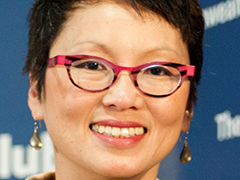Teaching Guide for Women Inspired Program
Background
In today’s world, highly talented women continue to face challenges that limit their success, career potential and general life satisfaction. In partnership with the GSB Women's Task Force, the GSB Alumni Relations Office makes these resources available to spark thinking and discussion on important topics of career navigation, leadership through awkward dynamics in the work place, work-life balance, and diversity.
These resources are designed to challenge you to grapple with the forces driving your own internal compass and gut reactions as you watch, discuss, and share a combination of both the Capstone Perspectives and Video Case Vignettes.
Women Inspired Program Vignettes
This content is designed from real stories and perspectives of diverse women with the simple assumption that career satisfaction and life success are driven by the ability of a woman to make consistent value judgments and decisions that are driven by an inspired perspective of oneself and ones life vision. The vignettes and cases are structured to spark personal reflection around one's own values and decision-making process, which will lead to transformative learning of practical ways to address challenges. The video case resources are made available to all alumni and the content is designed to be experienced individually, in a group discussion or with a professional coach.
The collection includes two different types of videos: Capstone Perspectives and Video Case Vignettes. The Capstone Perspectives feature a woman’s perspective, experience or advice on a particular topic or theme. The Video Case Vignettes focus on a particular challenge a woman faced, decisions she made, and what she learned from the experience.
Video Case Vignette Format
These case vignettes feature leaders who share their experiences and insights to help you understand the opportunities you have to hone your own thinking and career design. The case vignettes are broken into 3 clips: the background and challenge; the decision or action taken by the leader and the results of the case with lessons learned. At the end of each clip, take time to consider or discuss how you might handle the dilemma, whether or not you agree with the action that was taken, or what you might do differently and why. Take heed of the lessons learned and see what advice you can take from leaders who have gleaned important insights from their experiences.
How to Make the Most from the Video Vignettes
Try to watch a combination of Capstone Perspectives and Video Case Vignettes from different leaders. In many cases, you will see that leaders may handle the same question or challenge very differently. Consider which approach or perspective works for you.
As you watch the videos, reference the scrolling notes next to the video, which includes a brief background on the leader, a summary of the vignette, take-aways, and questions to consider. For every vignette, ask yourself whether or not you agree with the leader. Try to understand what values or frameworks are driving your reactions. If you have not yet faced a similar challenge, consider how you might use the challenge to prepare for what may lie ahead. You may also recall a very different challenge you have faced that brings you to a similar conclusion as the challenge in the video.
As the leader shares her challenge, imagine yourself in her shoes and how you would handle the situation. Pause the video to consider and/or discuss the challenge, how it is handled, and the lessons learned. Think about what you might do differently or what was done well. Use these stories and insights to consider the values and decision making processes that drive your own internal compass.
Take time to reflect on your own situation, goals, values, plans and future.
After you watch the video, ask yourself the simple question:
What will you continue doing? Start doing? Stop doing?
Additional Readings and Resources
http://gender.stanford.edu/programs
Video Vignette: Traditions of Family
Featuring: Van Ton-Quinlivan
Background on Leader: Van Ton-Quinlivan is Vice Chancellor of Workforce and Economic Development for the California Community Colleges. Ton- Quinlivan’s leadership focus is Doing What MATTERS for Jobs and the Economy with the goal of improving workforce outcomes for California’s 2.1 million community college students and fueling strong regional economies. She was named a White House Champion of Change in 2013 for her distinguished career in industry, education, and community service. She is vice chair of the National Skills Coalition, co-chair of the Workforce Action Team of the California Economic Summit, and serves on the California Council on Science and Technology. Ton-Quinlivan holds degrees from the Stanford Graduate School of Business, Stanford Graduate School of Education, and Georgetown University. She resides in California with her husband and two children.
Summary: Van talks about how traditions are important for children and what she does to build traditions in a very busy lifestyle.
Takeaway: Realize you are establishing traditions with your family through your habits and be intentioned about shaping the traditions you value.
Considerations and Questions:
1- Do you have traditions you are building with your family?
2- What are the traditions you should maintain?
3- What traditions build family cohesion?



